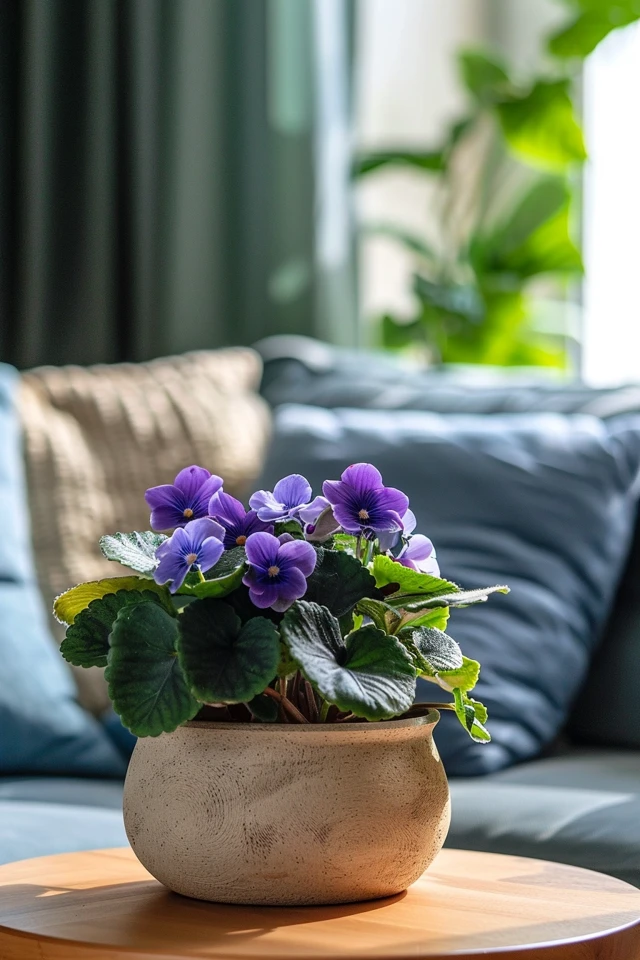Welcome to the world of African violet care! As an avid gardener, I understand the importance of proper pruning techniques for African violets. Pruning these beautiful plants is not only essential for maintaining their health but also for promoting new cycles of blooms. In this article, I will guide you through the process of pruning African violets with precision and care. Let’s dive in!
Key Takeaways:
- Pruning African violets can be done at any time of the year, but post-bloom is ideal for encouraging new blooms.
- Assess the plant’s health before pruning and ensure there are no pest or disease issues.
- Use small, sharp scissors or pruning shears to make precise cuts and minimize damage to the plant.
- Having the right tools, like pruning shears and trimming snips, is crucial for effective pruning.
- Sanitize your tools before and after each use to prevent the spread of diseases.
Tools for Pruning African Violets
When it comes to pruning African violets, having the right tools is essential for ensuring a successful and effective pruning process. Pruning shears and trimming snips are two of the most commonly used tools for this delicate task. These tools offer precision and control, allowing you to make clean cuts without causing unnecessary damage to the plant’s stems.
Pruning shears are particularly useful for cutting through thicker stems and branches, while trimming snips are perfect for snipping off smaller buds and leaves. By using these specialized tools, you can easily maintain the desired shape and size of your African violets.
Aside from choosing the appropriate tools, maintaining cleanliness is crucial to prevent the spread of disease. After each use, make sure to wipe down your pruning shears and trimming snips with a mild bleach solution or rubbing alcohol. This will help eliminate any potential pathogens that may be present on the tools, ensuring the health and well-being of your plants.

Pro Tip: Keeping your tools clean not only protects your African violets but also extends the lifespan of the tools themselves, preventing rust and corrosion.
In addition to cleanliness, maintaining sharpness in your tools is equally important. Sharp tools create cleaner cuts, minimizing damage and promoting faster healing for your plants. Regularly sharpening your pruning shears and trimming snips will ensure that you achieve precise cuts with minimal effort.
Now that you know the importance of having the right tools for pruning African violets, as well as the significance of cleanliness and sharpness, you can confidently embark on your pruning journey. Remember, proper pruning techniques combined with the right tools will help promote lush growth and vibrant blooms for your African violets.
Step-by-Step Pruning Instructions
Pruning an African violet requires following a step-by-step process. To ensure the health and vitality of your plant, it is important to follow these pruning instructions carefully.
1. Sanitize your scissors or shears
Before you begin pruning, it is crucial to sanitize your scissors or shears. This helps prevent the spread of diseases between plants. Clean your tools by wiping them with a mild bleach solution or rubbing alcohol. Make sure to dry them thoroughly before use.
2. Pinch off spent flowers
To encourage new blooms and maintain the overall appearance of your African violet, pinch off spent flowers. Gently hold the base of the flower and remove it by giving it a slight twist or snipping it off. This stimulates the plant to produce more flowers and prevents the formation of seed pods.

3. Remove bottom leaves
Regularly removing bottom leaves is essential for balancing growth and creating space for new leaves to develop. Gradually pinch or trim off the older, lower leaves every month. This practice helps maintain a tidy and compact growth habit, preventing overcrowding and promoting healthier foliage.
4. Identifying pruning targets
When pruning your African violet, it’s important to identify specific targets for pruning. Look for dead or damaged leaves and remove them at the base. Additionally, consider pruning basal leaves for aesthetic purposes or to propagate new plants. If you notice leggy stems that are stretching out, trim them back to promote a more compact and bushy growth pattern.
By following these step-by-step pruning instructions, you can maintain the health, shape, and beauty of your African violet. Now you have the knowledge to keep your plant thriving and blooming!

Conclusion
Pruning African violets offers a multitude of benefits for these delicate plants. By trimming away dead foliage and spent blooms, pruning helps to promote healthy growth and encourage a new cycle of vibrant flowers. Additionally, regular pruning helps maintain the overall health of the plant by preventing the spread of diseases and controlling its shape and size.
However, the benefits of pruning extend beyond the act itself. Post-pruning care plays a crucial role in ensuring the continued well-being of African violets. This care includes watering wisely, providing the right amount of fertilization to support future blooms, and creating optimal conditions of light and temperature.
Monitoring and adjusting the care routine according to the specific needs of the plant is also essential for its thriving. With proper pruning techniques and dedicated post-pruning care, African violets can reach their full potential, producing an abundance of vibrant blooms that will captivate any indoor garden enthusiast.

